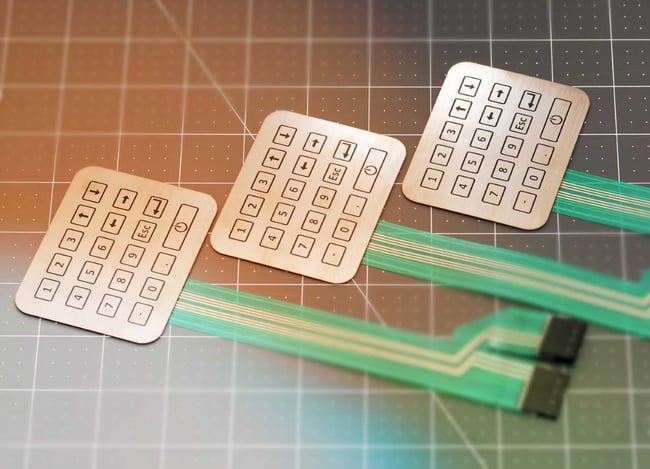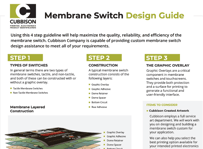Membrane switches, also known as membrane panels or keypads, are lightweight, all-in-one printed electrical circuits engineered to sustain millions of actuations. Membrane switches are constructed with layers of thin, flexible, and conductive materials rather than bulky, rigid materials, making them an optimal choice in most cases.
All membrane switches have at least five layers.
The graphic overlay, a membrane switch's top layer and point of human-machine interface, is typically made of polyester or polycarbonate. In addition to indicating user functions, these overlay graphics can provide branding, asset management, compliance, and safety information. Membrane switch overlays are easily customizable.
A retainer layer is used to secure the placement of metal domes in tactile switches.
A spacer layer allows for the switch's open position, so that a break in conductivity can occur.
A circuit layer facilitates the flow of electricity. Its conductivity can result from the use of conductive inks or from conductive copper traces that appear when a flexible film substrate is etched away.
A rear adhesive layer mounts the complete membrane switch to the product it is intended to control. Because membrane switches must be mounted to units with varying surface types, selecting the right adhesive is an important design decision.
Membrane Switch Application in the Food Industry
Our industrial food client depended on reliable temperature control for food storage. They were specifically concerned about durability since the food storage area would be cleaned daily with high-pressure water hoses and chemicals. Our team helped them select a membrane switch design to meet the stringent National Electrical Manufacturer Association Level 4 (NEMA 4) standards.
The Cubbison Company can comply with your specifications, or we can work with you to customize solutions that will function reliably, even in the most rigorous environments.
Because we offer turnkey services, you can eliminate the inconvenience of working with multiple manufacturers:
Printed circuit layers use conductive inks, typically silver or copper, to facilitate the flow of electricity. Substrates and inks have various levels of conductivity and resistance, making them important parts of membrane switch design.

The Cubbison Company can manufacture a membrane switch according to your specifications, or we can customize one according to your project needs.
The Cubbison Company's 4-step Membrane Switch Design Guide will help you make decisions about every aspect of your membrane switch. If you would like additional design insight, call (800) 733-4133 or email salesengineer@cubbison.com.

When you are designing a new product or working to establish specs for future manufacturing runs, you should consider three layers of defense against product malfunctions.
Safeguard #1: Do business with a reputable manufacturer. For some companies, cost-cuts result in quality shortcuts. Many clients have turned to our design engineers for a solution, after their first membrane switch design had malfunctioned.
Safeguard #2: Invest in prototypes. If you are investing in the design of a new product, or if you are making adaptations to an existing product design, consider spending a few extra days and a few extra dollars to get it right. The Cubbison Company's Rapid Prototype Program gives you an opportunity to test aesthetics, customer appeal, form, fit, and function, before you invest in a full product run.
Read more about our Rapid Prototype Program.
Safeguard #3: Insist on testing. Your product should never leave the manufacturing facility until it has been tested for form and function. By skipping this step, you increase the risk that your product will malfunction after it has been installed and put into operation. Unfortunately, this results in delays, lost productivity, and a costly return to the drawing board.